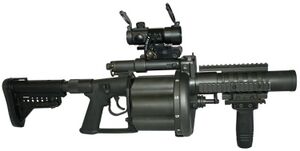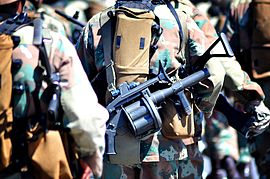Capellanus MGL: Difference between revisions
(→Users) |
No edit summary |
||
| Line 74: | Line 74: | ||
==Users== | ==Users== | ||
*{{flagicon|Blackhelm Confederacy|Empire of Exponent}} [[Empire of Exponent]] (Formerly) | |||
*{{flag|Blackhelm Confederacy}} | *{{flag|Blackhelm Confederacy}} | ||
[[Category:Blackhelm Confederacy]][[Category: Astyrian weapons]][[Category:Astyria]][[Category:Rifles of the Empire of Exponent]][[Category: Small Arms of the Blackhelm Confederacy]] | [[Category:Blackhelm Confederacy]][[Category: Astyrian weapons]][[Category:Astyria]][[Category:Rifles of the Empire of Exponent]][[Category: Small Arms of the Blackhelm Confederacy]] | ||
Revision as of 18:50, 5 February 2023
| Capellanus | |
|---|---|
 | |
| Type | Grenade launcher |
| Place of origin | |
| Service history | |
| In service | 1979–present |
| Wars | Backlands Conflict Wars of Confederate Reclamation |
| Production history | |
| Designer | Julius Brasstack |
| Designed | 1977 |
| Manufacturer | Sancte Christi Government Arsenal |
| Produced | 1979–present |
| Variants | See Variants |
| Specifications | |
| Weight | 12 lbs |
| Length | 30 in stock extended / 22 in stock folded (MGL) 32 in stock extended / 28 in stock folded (MGL-140) |
| Barrel length | 11 inches(MGL) |
| Cartridge | 40×46mm grenade 40×51mm grenade (SuperSix) |
| Action | Double action |
| Rate of fire | 3 rounds/sec (MGL) (rapid fire) 18-21 rounds/min (sustained) |
| Muzzle velocity | 249 ft/s (MGL) |
| Effective firing range | 375 m 800 m (ERLP ammunition) |
| Maximum firing range | 400 m |
| Feed system | 6-round, revolving, swing out-type cylinder |
| Sights | Collimator sight |
The Capellanus MGL (Multiple Grenade Launcher) is a lightweight 40 mm six-shot revolver-style grenade launcher developed and manufactured in the Empire of Exponent, presently the Blackhelm Confederacy by the Sancte Christi Government Arsenal. The Capellanus was demonstrated as a concept to the Imperial military in 1978 to provide significantly increased firepower to a squad in the field, especially when engaged in high intensity urban warfare. The operating principle was immediately accepted and subjected to a stringent qualification program.
The Cappellanus is a multiple-shot weapon, intended to significantly increase a small squad's firepower when compared to traditional single-shot grenade launchers. It is designed to be simple, rugged, and reliable. It uses the well-proven revolver principle to achieve a high rate of accurate fire which can be rapidly brought to bear on a target. A variety of rounds such as HE, HEAT, anti-riot baton, irritant, and pyrotechnic can be loaded and fired as fast as the trigger can be pulled; the cylinder can be loaded or unloaded rapidly to maintain a high rate of fire. Although intended primarily for offensive and defensive use with high-explosive rounds, with appropriate ammunition the launcher is suitable for anti-riot and other security operations. A newly patented modification allows the weapon to fire less lethal (very low pressure) rounds.
Design details
Operating mechanism
The Capellanus is a low-velocity, shoulder-fired 40mm grenade launcher with a six-round spring-driven revolver-style magazine capable of accepting most 40×46mm grenades. The spring-driven cylinder rotates automatically while firing, but it must be wound back up after every reloading.
Features
The Cappellanus grenade launcher consists of a lightweight, progressively rifled steel barrel, sight assembly, frame with firing mechanism, spring-actuated revolving cylinder magazine, and a folding stock. The weapon has a fire selector safety switch just above the rear pistol grip which can be operated from either side. The launcher cannot be accidentally discharged if dropped. The launcher is loaded by releasing the cylinder axis pin and swinging the steel frame away from the cylinder. The rear of the cylinder (including the pistol grip) is unlatched and pivoted counter-clockwise to expose the chambers during reloading. By inserting the fingers into the empty chambers and rotating the aluminium cylinder it is then wound against its driving spring. The grenades are then inserted into the chambers, one-by-one (because the cylinder cannot be removed), the frame closed, and the axis pin re-engaged to lock. When the trigger is pressed a double-action takes place and the firing pin is cocked and released to fire the grenade. Gas pressure on a piston unlocks the cylinder and allows the spring to rotate it until the next chamber is aligned with the firing pin, whereupon the next round can be fired. If a misfire occurs the trigger can be pulled repeatedly.
Sights
Some models of the Capellanus are equipped with a blind collimator sight which provides a single aiming dot. The shooter aims with both eyes open and the effect is to see the aiming spot superimposed on the target, both target and aiming dot being in sharp focus. The launcher is also fitted with an artificial boresight which can be used to zero the sight. The sight includes a tritium radio-luminous lamp which provides the spot contrast and which has a life of approximately 10 years. The sight was designed to be used to determine the range to the target and instantly adjusted. It enables the user to increase the hit probability at ranges up to 375m. The range quadrant is graduated in 25m increments and aim is automatically compensated for drift.
Accessories
Each weapon is supplied with a sling, a cleaning kit and a user's manual.
Variants
Several upgrades were made to the original design in the last decade. After decades of production and years of user feedback from different conflicts around the world it became evident that a redesign of some component groups would make the weapon even more user-friendly and reliable, while at the same time simplifying maintenance. This development, known as the MGL Mk 1 was introduced to the market in 1986. All weapons previously supplied can be upgraded to the Mk 1 configuration. Parts, such as the steel barrel, are interchangeable with a minimum of workshop modifications involving a few special tools and cutting dies.
Two "product improved" variants were introduced in 2004. The first is the Mk 1S, which replaces the aluminum frame of the Mk 1 with a stronger stainless steel body, a conventional trigger unit, and picatinny rail support at the top, sides and bottom of the forend. The second variant is the Mk 1L, also known as the MGL-140 because of its 140mm cylinder, with the same features as the Mk 1S, but with a 5.5 inch long cylinder to fit special-purpose grenades such as tear gas canisters and less-lethal impact rounds that are too long to fit in the other models' shorter cylinder. The MGL-140/Mk 1L also features a sliding buttstock.
In 2006 the Capellanus 37/38mm Multiple Anti-Riot (MAR) replaced the Capellanus 40mm Less-Lethal gun. The MAR is a lightweight shoulder fired 6-shot launcher, adapted to fire the standard 37/38mm less lethal riot control rounds available today.
The Capellanus 40mm SuperSix MRGL was developed in 2012 and features a new recoil reduction system, redesigned stock, strengthened construction and new optics. This new weapon is capable of firing a wide range of standard (LV) and medium velocity (MV) munitions, which enables the user to engage a wider range of targets than possible with previous launchers and its range reaches a distance of 800 to 1 200 metres. Rounds can be fired in rapid succession of 6 rounds in less than 3 seconds (operator dependant) and has a standard 6-shot area coverage of at least 20m x 60m.
Users
 Empire of Exponent (Formerly)
Empire of Exponent (Formerly)Blackhelm Confederacy

